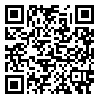BibTeX | RIS | EndNote | Medlars | ProCite | Reference Manager | RefWorks
Send citation to:
URL: http://bcn.iums.ac.ir/article-1-278-en.html
Introduction: It has been shown that administration of WIN55,212-2, a cannabinoid receptor agonist, into the basolateral amygdala (BLA), dose-dependently increases the thermal latency to withdrawal in the tail-.ick test and decreases pain related behaviors in both phases of the formalin test. Recent human and animal imaging data suggest that the nucleus accumbens (NAc) is an important neural substrate of pain modulation. Because the NAc also receives abundant glutamatergic .bers from the BLA which converge with hippocampal .bers on the same NAc neurons, it is reasonable to ask whether AMPA/kainate and NMDA receptor antagonists may also include in the amygdala-accumbens pathway in pain modulation.
Methods: In the present study, we examined the role of NMDA and AMPA/kainate receptors within the NAc in antinociception induced by intra-BLA injection of the cannabinoid receptor agonist WIN55,212-2 in rats. Seventy two adult male albino Wistar rats weighing 230-280 g were implanted with two separate cannulae into the BLA and the NAc. Also, animals received intra-accumbal infusions of either NMDA receptor antagonist, AP5 (0.5, 2.5 and 5 μg/0.5 μl saline) or AMPA/kainate receptor antagonist, CNQX (0.1, 0.5 and 2.5 μg/0.5 μl DMSO) 2 min before microinjection of WIN55,212-2 into the BLA (15 μg/rat).
Results: Antinociceptive effects of WIN55,212-2 were measured in the formalin test (50 µl injection of formalin 2.5% subcutaneously into the hindpaw) and pain-related behaviors were monitored for 60 min. Results showed that intra-accumbal AP5 and CNQX dose-dependently prevented antinociception induced by intra-BLA administration of WIN55,212-2 in time set intervals. Additionally, intra-accumbal AP5 administration of both AP5 (5 μg/0.5 μl saline) and CNQX (2.5 μg/0.5 μl DMSO), alone, could not signi.cantly change the pain scores in the rats.
Discussion: It seems that glutamate receptors located in the NAc, partially mediate the antinociceptive responses of cannabinoid within the BLA in persistent in.ammatory model of pain.
Received: 2012/09/18 | Published: 2012/09/15
| Rights and permissions | |
 |
This work is licensed under a Creative Commons Attribution-NonCommercial 4.0 International License. |





